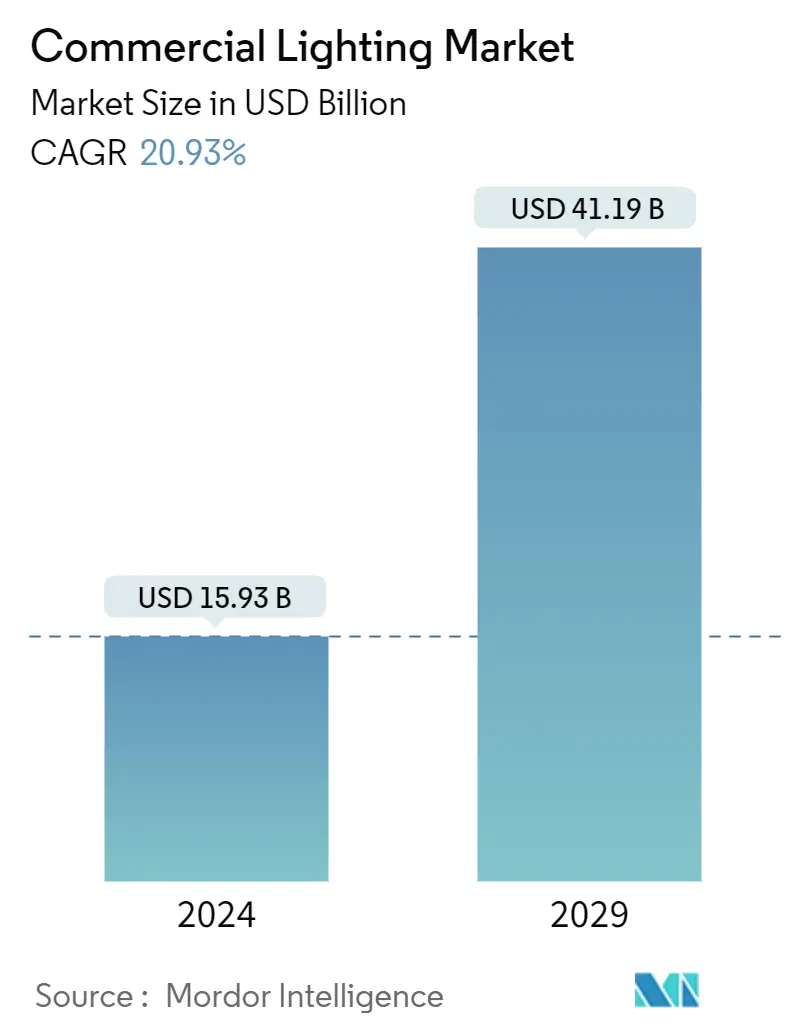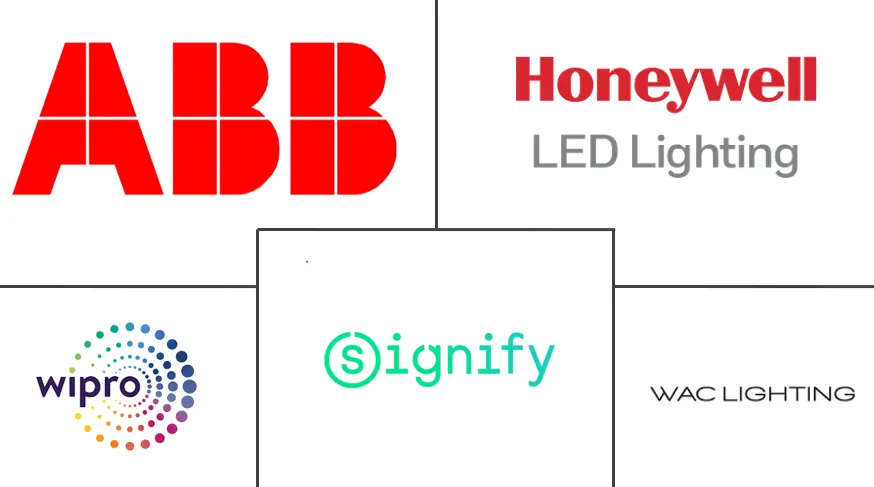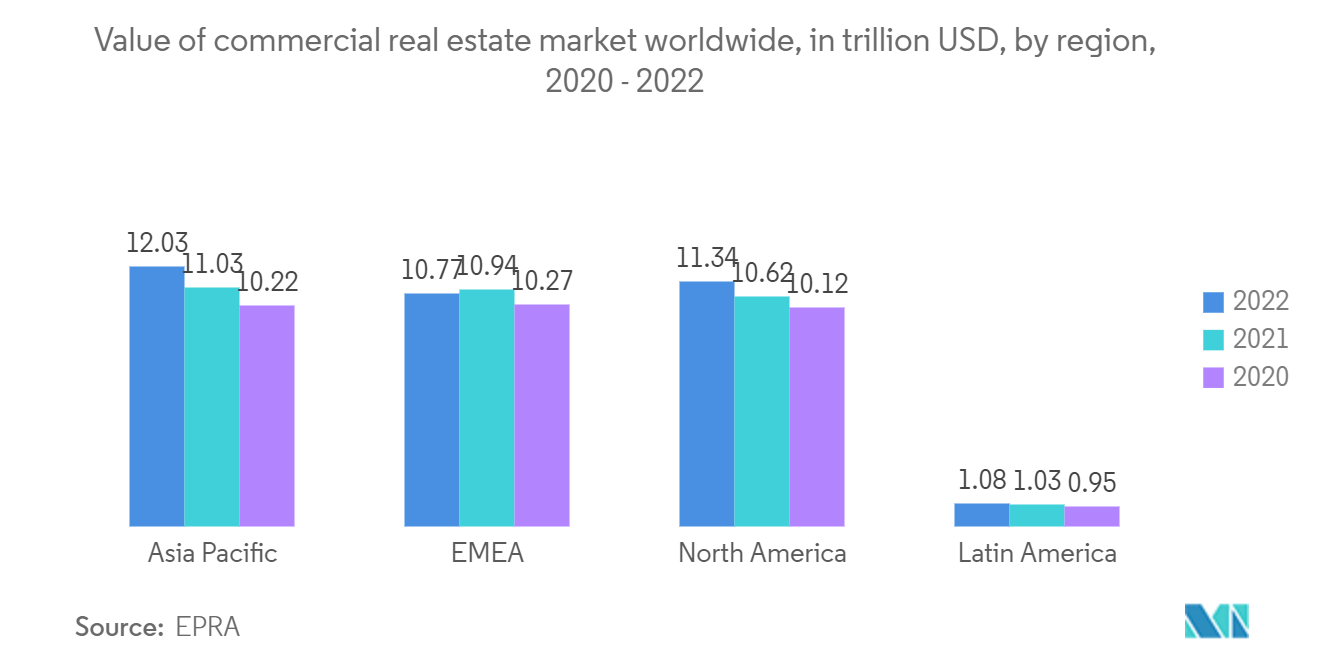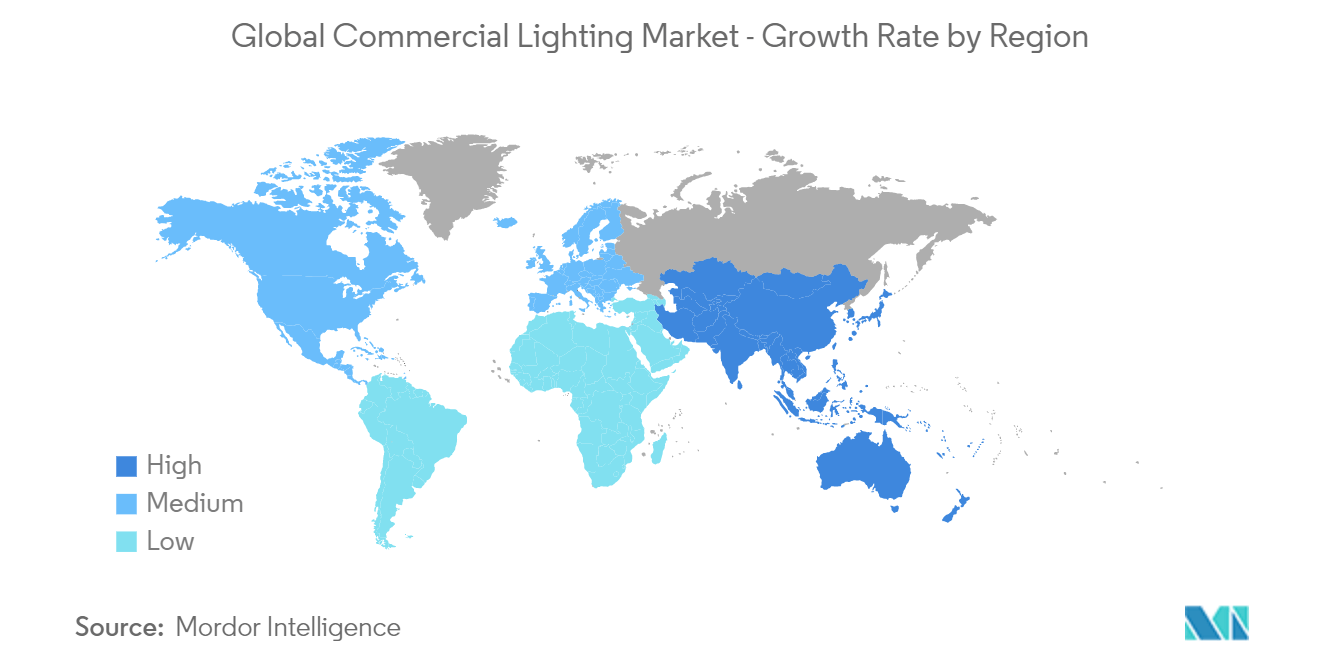Commercial Lighting Market Size

| Study Period | 2019 - 2029 |
| Market Size (2024) | USD 15.93 Billion |
| Market Size (2029) | USD 41.19 Billion |
| CAGR (2024 - 2029) | 20.93 % |
| Fastest Growing Market | Asia-Pacific |
| Largest Market | Asia-Pacific |
Major Players
*Disclaimer: Major Players sorted in no particular order |
Commercial Lighting Market Analysis
The Commercial Lighting Market size is estimated at USD 15.93 billion in 2024, and is expected to reach USD 41.19 billion by 2029, growing at a CAGR of 20.93% during the forecast period (2024-2029).
The growth of the studied market is being significantly fueled by the ongoing and upcoming smart city projects in several nations, the increased focus of governments worldwide on energy consumption, the rising demand for LED lights and luminaires for outdoor applications, and the expanding acceptance of standard protocols for lighting control systems.
Commercial lighting may be customized to fit any facility and its operations based on use. Maintenance requirements, brightness level, and warranties are all significant factors in commercial lighting. Many people can be accommodated in a commercial facility for various activities, including shopping, employment, entertainment, and medical inspection. A lighting design company creates designs that reflect the activity carried out in the facility to ensure that workers are comfortable and that the lux level requirements and the energy efficiency criteria are adequate.
Commercial lighting design must consider light fixtures' use, characteristics, and purpose. T5 and compact fluorescent lights are typical business lighting design fixtures, although LED light fixtures are gaining popularity because of their lower prices.
Well-designed lighting fixtures may illuminate a room's surroundings and create a positive atmosphere. The lighting design at hospitals, hotels, clubs, offices, retail stores, and other commercial facilities must be carefully considered. This is so that business owners may make their location seem welcoming to guests or clients by using a well-designed commercial lighting framework.
Furthermore, it is now simpler for firms to highlight their interiors and design a functional workspace thanks to technology advancements like artificial intelligence and LED lighting. The commercial lighting industry always innovates to lower energy costs, greatly impacting lighting products.
Commercial Lighting Market Trends
Commercial Offices segment to maximum market share
Commercial office lighting is one of the work environment's most frequently disregarded and undervalued elements. Picking the appropriate workplace lighting fixtures might be among the wisest financial decisions. It can affect customer happiness, building security, personnel morale, and productivity in addition to the former.
Government structures, medical facilities, workplaces, retail establishments, institutions, and other locations frequently employ commercial office lighting. Commercial-grade lighting is robust and may use cutting-edge technologies to boost efficiency and user-friendliness. Office lighting may influence visitors' and employees' moods, improve productivity, and improve the visual attractiveness of the area. The ideal workplace lighting conforms with safety standards, creates a comfortable environment, and offers an appropriate mix of natural and artificial light.
Commercial lighting systems could also have intelligent controls, including sensors, dimmers, timers, programmable lighting systems, and LED technology. By automatically altering lighting settings based on occupancy, daylight levels, or time of day, these controls can assist in optimizing energy consumption and produce additional energy savings. Commercial areas can benefit from intelligent lighting controls that provide customized lighting settings, remote control, and interaction with other building management systems.
The main growth drivers are tightening laws regarding inefficient lighting systems and increasing government initiatives to promote sustainable development. The market's rise has been fueled by a sharp reduction in Light-Emitting Diode (LED) pricing and global energy policy changes. Furthermore, using attractive incentives and rebates offered by the governments of various nations for the use of LED lighting would boost demand.
The advantages that LED lighting provides, like its ability to switch on and off in a millisecond and its capacity to save money and extend product life, drive market demand for the technology. Demand is predicted to increase due to the benefit of directed, controlled light. Technological developments and the availability of different design alternatives for fixtures and lights owing to their compact shape and characteristics, such as daylighting, occupancy sensing, dimmability, and timer, are projected to affect the growth favorably. The industry has grown further due to governments' energy conservation initiatives, which offer financial incentives and enticing refunds to people and businesses in commercial settings.
According to EPRA, The value of the worldwide commercial real estate market is predicted to reach USD 35 trillion in 2022, up from around USD 34 trillion the previous year. With a market size of over USD 12 trillion, the Asia-Pacific area outpaced North America in terms of size.
Moreover, office spaces are evolving away from the individual cubicle setting in favor of an open-office environment. In this new, open environment, the ambient room lighting is focused on creating a sense of unity and community in the room and among workers.

China in the Asia-Pacific region to exhibit highest growth rate
Products for lighting are crucial for infrastructure, daily living, and industry. The mainland's need for illumination is growing along with China's economy and rising living standards. China has been the world's top producer and consumer of lighting for the past 20 years because of the lighting industry's fast development.
Organic light-emitting diodes (OLEDs), compact fluorescent lamps (CFLs), electrodeless discharge lamps (EDLs), and light-emitting diodes (LEDs) are some of the most popular items. To draw clients, Chinese businesses are investing more money in lighting malls. Office, school, and hospital lighting have all significantly improved.
China has been promoting environmental protection and energy conservation. A succession of policies and regulations, such as The Energy Conservation Law of the People's Republic of China and Opinions on Accelerating the Development of Energy-saving and Environmental Protection Industries, is driving the development of environmental protection services. At the same time, promoting energy-saving and eco-friendly products is creating greater demand for energy-efficient lighting. The priority given by China to the policy of developing energysaving and environmental protection industries is propelling the development of LED lighting.
Moreover, LED lights are rapidly replacing conventional lighting products in China. The Chinese government is also significantly driving the sector's growth by offering large-scale subsidies for adopting LED products. Moreover, the Chinese government has also banned incandescent bulbs, with the National Development and Reform Commission first announcing the country's incandescent bulb phase-out roadmap in November 2011.
As China's LED Lighting enterprises have gradually come of age, they have begun aggressively developing overseas markets. For example, Forest Lighting has merged with Germany's LEDVANCE, while Opple Lighting has set up several overseas subsidiaries. Meanwhile, mainland lighting companies have expanded their domestic presence by setting up display centers and adding specialty stores. In the future, mainland enterprises are expected to invest more in technology and innovation to increase the added value of their products and raise their competitiveness.

Commercial Lighting Industry Overview
There is intense competition among major vendors in the market. Due to a broad range of suppliers of commercial lighting products, buyers can choose from numerous vendors, creating cut-throat competition among vendors of equal caliber in product portfolio and geographical reach. Further, companies are innovating in terms of various connected lighting products. Players like Wipro and Signify are trying to provide smart lighting products for commercial applications like retail, hospitals, etc.
In June 2022, Wipro Lighting announced the establishment of a new business unit integrating Commercial Lighting and Seating solutions. Utilizing Wipro's shared dealership network and providing customer service, the new entity was established to provide better alliances and expedite growth.
In January 2022, Acuity Brands, Inc., a prominent industrial technology company, announced that it is expanding its partnership with Microsoft to bring new capabilities to Acuity Brands' bright lighting, building automation solutions, and lighting controls. By integrating the power of Microsoft's Cloud for Sustainability and Microsoft Azure IoT with Acuity Brands customer solutions, Acuity Brands and Microsoft would jointly facilitate end customers, operating numerous types of facilities and buildings, to calculate and forecast the environmental and financial impacts that these new lighting and building management technologies deliver.
Commercial Lighting Market Leaders
-
ABB Ltd
-
Honeywell LED Lighting
-
Wipro Lighting Limited
-
Signify NV (Philips Lighting)
-
WAC Lighting
*Disclaimer: Major Players sorted in no particular order

Commercial Lighting Market News
- Feb 2024: Signify launched the Philips Smart light hub in Chennai. The newly launched Smart light hub is built to give the customers a hands-on experiential tour of the products. It is spread over 2200 sq. ft. and offers more than 400 SKUs of smart lighting products, including product categories such as Smart Wi-fi LED lights, modular COB range, magnetic tracks, LED strips, and decorative lighting for indoor and outdoor applications among others.
- January 2023: Wipro Lighting introduced its innovative Flameproof Lighting line, Blazeline. This range offers industry-leading flameproof lighting solutions engineered to endure hazardous zones and environments. All products within the Blazeline series are CMFR, BIS, and PESO certified, thus ensuring maximum safety and quality.
Commercial Lighting Market Report - Table of Contents
1. INTRODUCTION
- 1.1 Study Assumptions and Market Definition
- 1.2 Scope of the Study
2. RESEARCH METHODOLOGY
3. EXECUTIVE SUMMARY
4. MARKET INSIGHTS
- 4.1 Market Overview
-
4.2 Industry Attractiveness - Porter's Five Forces Analysis
- 4.2.1 Bargaining Power of Suppliers
- 4.2.2 Bargaining Power of Buyers
- 4.2.3 Threat of New Entrants
- 4.2.4 Threat of Substitutes
- 4.2.5 Intensity of Competitive Rivalry
- 4.3 Industry Ecosystem Analysis
- 4.4 LED Trade Analysis and the Impact of US-China Trade War on the LED Market (Qualitative Trends)
- 4.5 Impact of COVID-19 on the LED Lighting/Emergency Lighting Market
5. MARKET DYNAMICS
-
5.1 Market Drivers
- 5.1.1 Move toward Energy-efficient and Connected Lighting Solutions driven by Growing Awareness and Smart Office Initiatives
- 5.1.2 Availability of LED-based Lighting Solutions as a Standardized Feature Coupled with Incremental Technological Advancements in the Sector
-
5.2 Market Challenges
- 5.2.1 The Sector is Susceptible to Broader Conditions, such as Construction Activity
6. MARKET SEGMENTATION
-
6.1 By Type
- 6.1.1 Lamps
- 6.1.2 Luminaries
-
6.2 By Lighting Type
- 6.2.1 LED-based lighting
- 6.2.2 Traditional
-
6.3 By End-user
- 6.3.1 Commercial Offices
- 6.3.2 Retail
- 6.3.3 Hospitality and Leisure (Restaurants and Sporting facilities)
- 6.3.4 Healthcare
- 6.3.5 Other End-users
-
6.4 By Geography
- 6.4.1 North America
- 6.4.1.1 United States
- 6.4.1.2 Canada
- 6.4.2 Europe
- 6.4.2.1 United Kingdom
- 6.4.2.2 Germany
- 6.4.2.3 France
- 6.4.2.4 Rest of Europe
- 6.4.3 Asia-Pacific
- 6.4.3.1 China
- 6.4.3.2 Japan
- 6.4.3.3 India
- 6.4.3.4 Rest of the Asia Pacific
- 6.4.4 Latin America
- 6.4.5 Middle East and Africa
7. COMPETITIVE LANDSCAPE
-
7.1 Company Profiles
- 7.1.1 Signify NV (Philips Lighting)
- 7.1.2 WAC Lighting
- 7.1.3 Cree Lighting (IDEAL INDUSTRIES INC,)
- 7.1.4 Siteco GmbH
- 7.1.5 Wipro Lighting Limited
- 7.1.6 Acuity Brands Inc.
- 7.1.7 Hubbell Incorporated
- 7.1.8 Zumtobel Group AG
- 7.1.9 ABB
- 7.1.10 Honeywell LED Lighting
- *List Not Exhaustive
8. INVESTMENT ANALYSIS
9. FUTURE OF THE MARKET
** Subject To AvailablityCommercial Lighting Industry Segmentation
Commercial lighting is utilized in places not residential, industrial, or manufacturing-related, such as offices, shops, institutions, hospitals, and government buildings. Commercial lighting often has a more significant initial cost, a longer lifespan, better durability, higher maintenance and repair expenses, and better energy-saving choices than other forms of lighting. The most crucial purpose in business buildings is often finishing a task or activity. To guarantee that employees working in the area are comfortable and that the lux level requirements and energy efficiency standards are appropriate, a lighting design business should produce designs representing the sort of activity conducted in the facility.
The Global Commercial Lighting Market is segmented by Type (Lamps, Luminaries), Lighting Type (LED-based lighting, Traditional), End-user (Commercial Offices, Retail, Hospitality, and Leisure (Restaurants and Sporting facilities), Healthcare), and Geography (North America, United States, Canada, Europe (United Kingdom, Germany, France, Rest of Europe), Asia-Pacific (China, Japan, India and Rest of Asia-Pacific), Latin America, Middle East and Africa). The report offers the market size in value terms in USD for all the abovementioned segments.
| By Type | Lamps | |
| Luminaries | ||
| By Lighting Type | LED-based lighting | |
| Traditional | ||
| By End-user | Commercial Offices | |
| Retail | ||
| Hospitality and Leisure (Restaurants and Sporting facilities) | ||
| Healthcare | ||
| Other End-users | ||
| By Geography | North America | United States |
| Canada | ||
| By Geography | Europe | United Kingdom |
| Germany | ||
| France | ||
| Rest of Europe | ||
| By Geography | Asia-Pacific | China |
| Japan | ||
| India | ||
| Rest of the Asia Pacific | ||
| By Geography | Latin America | |
| Middle East and Africa |
Commercial Lighting Market Research FAQs
How big is the Global Commercial Lighting Market?
The Global Commercial Lighting Market size is expected to reach USD 15.93 billion in 2024 and grow at a CAGR of 20.93% to reach USD 41.19 billion by 2029.
What is the current Global Commercial Lighting Market size?
In 2024, the Global Commercial Lighting Market size is expected to reach USD 15.93 billion.
Who are the key players in Global Commercial Lighting Market?
ABB Ltd, Honeywell LED Lighting, Wipro Lighting Limited, Signify NV (Philips Lighting) and WAC Lighting are the major companies operating in the Global Commercial Lighting Market.
Which is the fastest growing region in Global Commercial Lighting Market?
Asia-Pacific is estimated to grow at the highest CAGR over the forecast period (2024-2029).
Which region has the biggest share in Global Commercial Lighting Market?
In 2024, the Asia-Pacific accounts for the largest market share in Global Commercial Lighting Market.
What years does this Global Commercial Lighting Market cover, and what was the market size in 2023?
In 2023, the Global Commercial Lighting Market size was estimated at USD 12.60 billion. The report covers the Global Commercial Lighting Market historical market size for years: 2019, 2020, 2021, 2022 and 2023. The report also forecasts the Global Commercial Lighting Market size for years: 2024, 2025, 2026, 2027, 2028 and 2029.
Commercial Office Lighting Industry Report
Statistics for the 2024 Commercial Lighting market share, size and revenue growth rate, created by Mordor Intelligence™ Industry Reports. Commercial Lighting analysis includes a market forecast outlook to for 2024 to 2029 and historical overview. Get a sample of this industry analysis as a free report PDF download.



